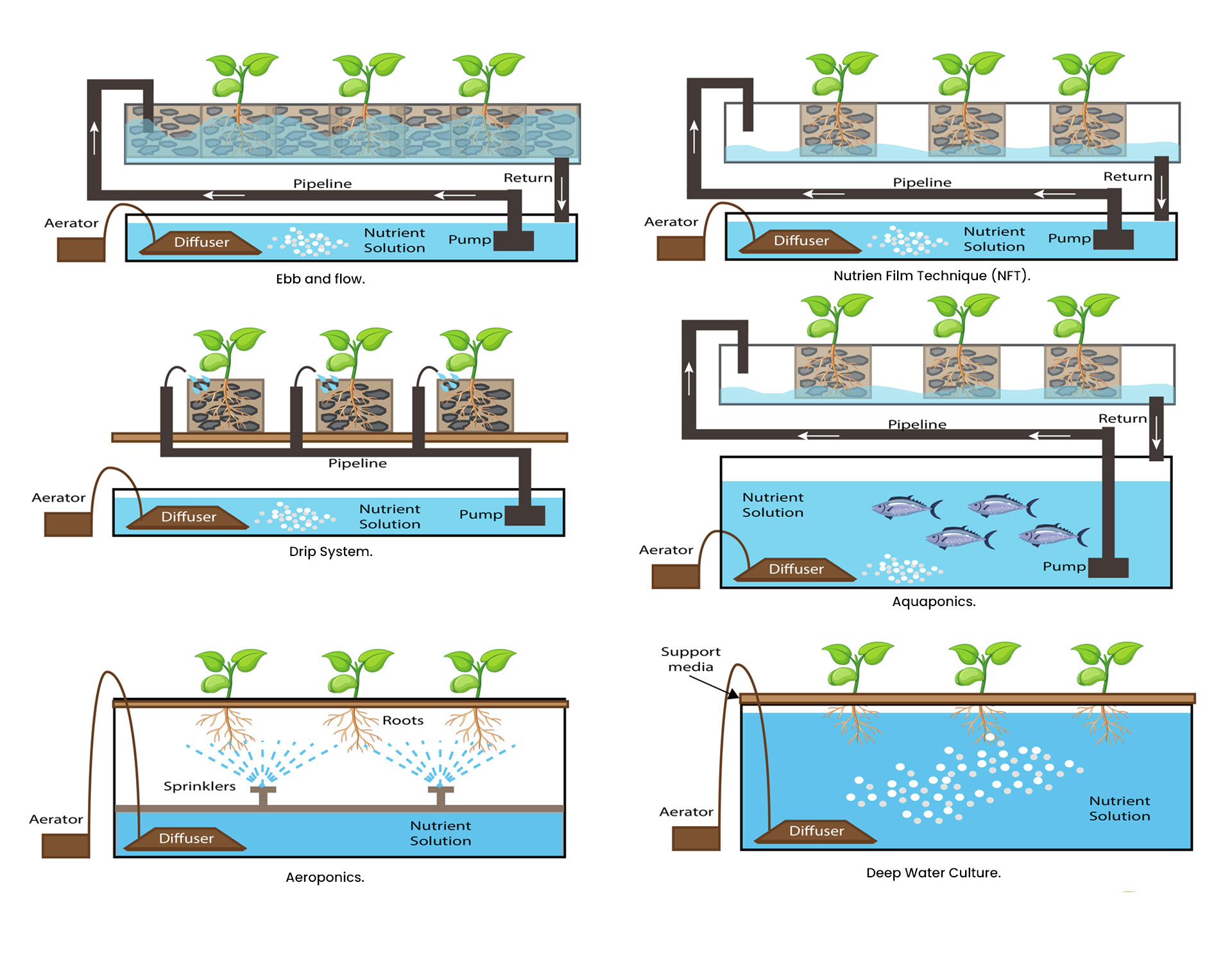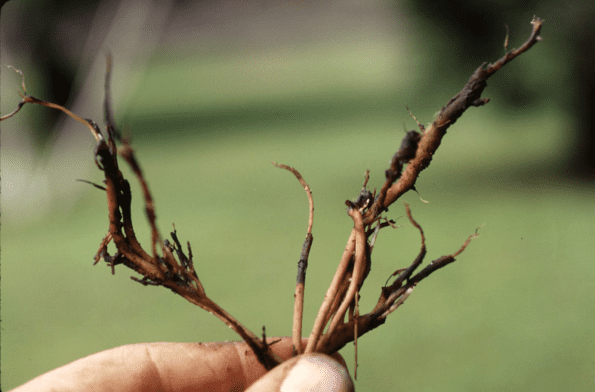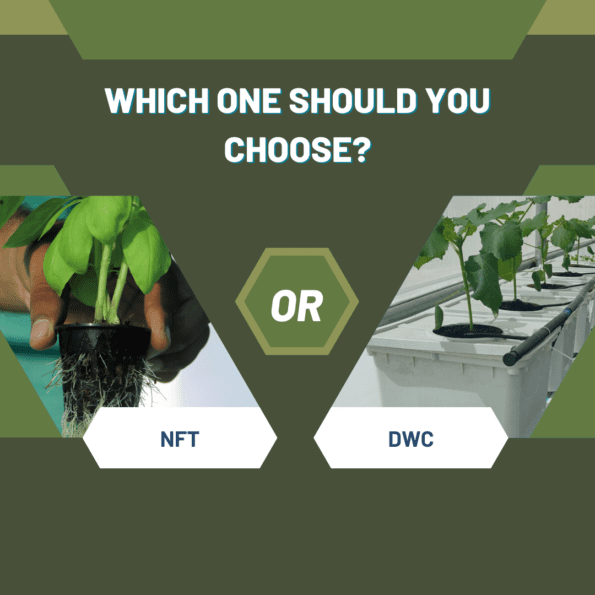What is a Hydroponic System?
Hydroponic systems are an increasingly popular way to grow plants without using soil. With various options available, deciding which system suits your needs can be difficult. From the ebb and flow systems to deep water culture, there is a hydroponic system that can fit any budget and space. In this article, we will explore the different types of hydroponic systems and their advantages so that you can make an informed decision about which system is right for you.
Table of Contents
How Does it Work?
Plants are grown hydroponically, which means using water. Hydroponic plants are nourished with nutrient-rich water while being planted in inert growing media. This technique encourages quick development, greater yields, and improved quality.
Types of Hydroponic Systems & Their Benefits
Plants need water, nutrients and oxygen to thrive. There are six hydroponic systems, based on different ways by which these requirements are fulfilled.

- Ebb and Flow System: To provide stability, a medium like perlite is needed. The tray containing the plants is periodically pumped with water and mineral solutions. The residual solution drains back to the reservoir after being absorbed by the plants. This straightforward approach is employed in backyard gardens. It is used to grow Basil, Lettuce and Parsley.
- Nutrient Film Technique (NFT): Plants are housed in sloped wooden/PVC channels. Pumps are used to move the mineral solution to the channel’s high point, where water that has fallen is collected and used again. This technique is used to cultivate plants with deep roots.
- Drip Systems: One of the most efficient systems to grow crops as the drip system keeps it simple for water & nutrient delivery. The growth of crops is improved by automatic flow of nutrient rich water at regular intervals. This system is considered efficient as it saves a lot of water, nutrients, and the automation helps in saving time.
- Aquaponics: Aquaponics is a combination of hydroponics and aquaculture, where fish waste is used as a nutrient source for plants. The plants, in turn, filter the water for the fish, creating a self-sustaining ecosystem.
- Aeroponics: This NFT-like technology is based on water and doesn’t need a medium. The mineral solution is sprayed onto the plants as mists. Although challenging to set up, this is advantageous in a large business context.
- Deep Water Culture (DWC): The plant’s root is suspended in oxygenated, mineral-rich water in a container where an air pump is used to oxygenate the water. This process is simple and low maintenance.
The benefits of Hydroponic systems
Since the beginning of time, people have employed hydroponics. One illustration of this is Hanging Gardens of Babylon. Hydroponically growing plants has a lot of advantages.
- Plants develop more quickly, increasing yield.
- anywhere, even in greenhouses, underground, and on rooftops.
- Plants can be cultivated instead of traditional farming in places where it is feasible.
- Water and nutrients are recycled and reused
- Organic food can also be grown without the use of fertilizers or pesticides.
- Numerous space research initiatives employ hydroponics. Hydroponics is the best method for growing food in locations without access to soil.
Nutrient Film Technique (NFT) VS Deep Water Culture (DWC): Which one should you Choose?
Deep Water Culture (DWC) is more user-friendly because it gives you more room for error, especially if you’re a novice hydroponic producer. Because it necessitates a little more close monitoring, particularly in the event of a power loss, the Nutrient Film Technique (NFT) technology is more advanced. In a DWC system as opposed to an NFT system, it is simpler and easier to maintain a consistent nutrient solution temperature.
Deep Water Culture (DWC) is more straightforward, uses more water, and has less temperature swings. Additionally, DWC would have less space between its roots and the water before it. Greater air exchange and perhaps better results overall would be provided by NFT. Also, less water and nutrients would be used for NFT.
NFT would therefore produce the best outcomes because it uses less water. When it’s incredibly hot out, NFT systems work better. The water can reach up to 85 degrees during the summer, and DWC requires extensive aeration to maintain high oxygen levels. Due to the NFT’s vast surface area and passive gas exchange, the oxygen levels remain high.
How ambitious you want to be will determine this. DWC would generally be simpler to set up and operate well. However, you are constrained by baggage and space. You can move vertically with NFT and have more “room” to expand. Additionally, if you are growing in your basement, you must take lighting for all of your plants into consideration in contrast to DWC, where light is on the totes. The Nutrient Film Technique (NFT) System is definitely the route I would choose.
The Cost and Maintenance of hydroponic system
Cost of Hydroponic system
Urban agriculture greatly benefits from hydroponic farming, which is vertical farming without soil. We use a water solution that contains the minerals plants require. Hydroponic gardening doesn’t need soil. We are able to carry out hydroponic gardening even in a small area. Constructing a hydroponic farming system accurately works similarly to how a precision farming system operates. A commercial Hydroponics would cost around 12 lakhs for a space of 10000 sq ft and for a terrace set-up it would cost 2 lakhs
Maintenance of hydroponic system
The nutrient solution (fertilizer and water) should always be drained, cleaned, and refilled at least one or two times a month. Since plants grown hydroponically do not require soil, there is less maintenance, no weeding, and no soil-borne diseases or pests to worry about.
Once you have your hydroponic system set up, you have to take good care of it. At first, hydroponic system maintenance can seem daunting, but don’t worry. Once you have the basics down, it gets much easier. We’ll take a look at the basics of hydroponic system maintenance and monitoring, so you can keep your system clean and your plants happy.
An important part of keeping healthy hydroponic plants is paying attention to them. It’s not enough to simply monitor and maintain your hydroponic system- you need to examine your plants regularly. If you take time to inspect your plants, you can spot problems right away, rather than notice an issue only when your hydroponics plants are dying. Think of hydroponic system maintenance as a holistic practice. As you test and change out the water, make sure the water looks clean. Basically, make sure you don’t see debris, algae, or fungus developing. Check the water and make sure you don’t notice any discoloration. Start by looking at your plants’ roots if you are using a system where plant roots are visible. Healthy roots should be smooth in texture, with a pearly or creamy white color; new roots are often whiter than older growth.
Signs of problems in root systems can include

We must check that the plants and roots are healthy. Here is how to check fault in roots
- Yellow or brown color
- Very tangled root system
- Having a slimy feel or appearance
- Having an abnormal odor
- Blackish color, dying or dead roots
Any of these signs can indicate root, chemical burn, or even harmful bacterial and fungal presence. The good news is that if you recognize these symptoms early on, you can usually save your plants and prevent the problem from spreading.
Conclusion
Hydroponics comes in different models and it can be customized based on your individual or commercial need. There is no best or right one in Hydroponics. Choose the comfortable one based on your exact requirement, and consider the pros & cons of the particular system before you invest. In our experience, we always suggest people to go with Drip System or NFT in order to save their time and spend on automation. These two methods are proven to give definite yield, which is both high in terms of quality & quantity. Check this blog How to start your balcony/terrace garden? if you are looking to start Hydroponics on a small scale (especially in your own terrace). Happy Gardening!









